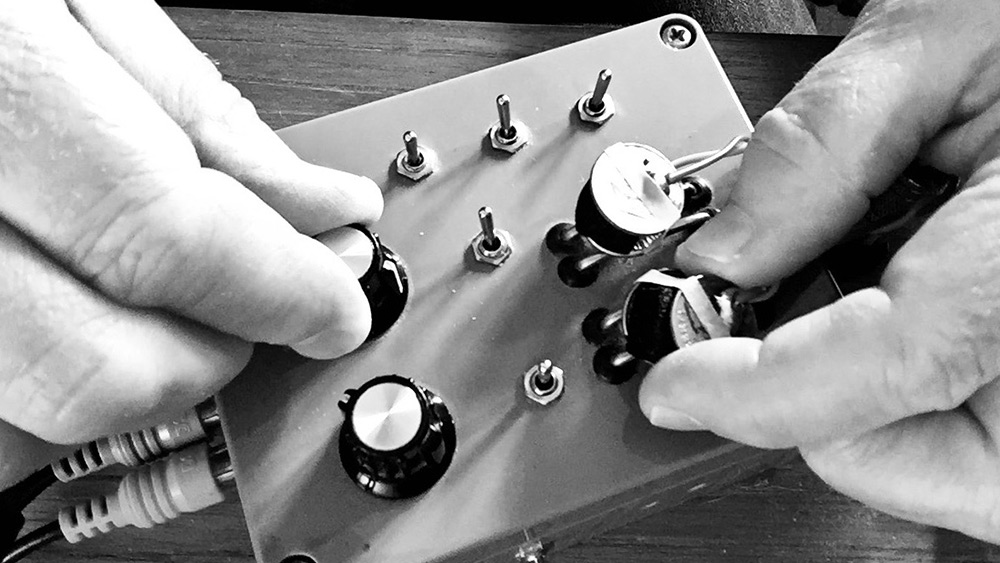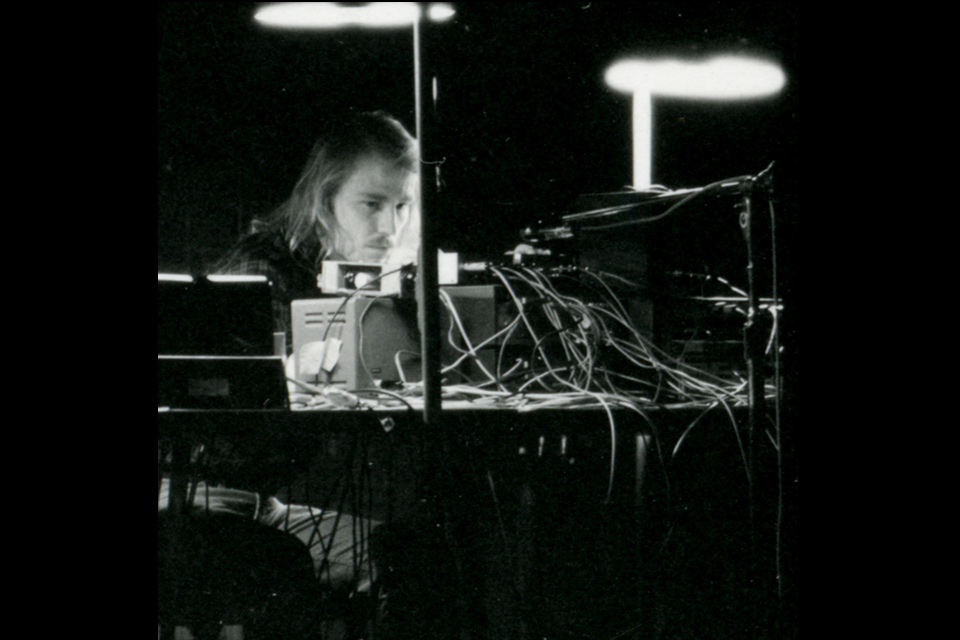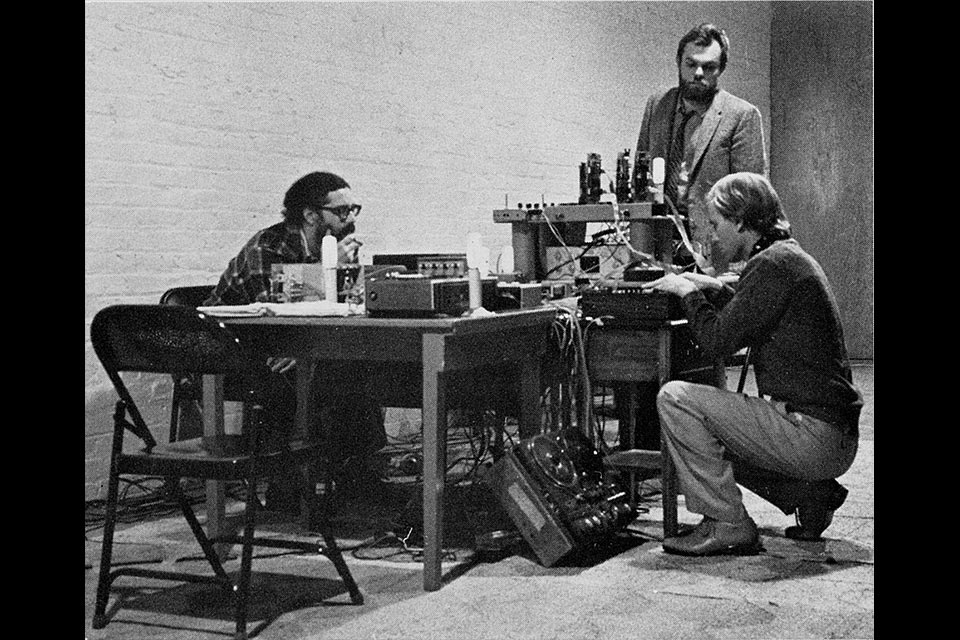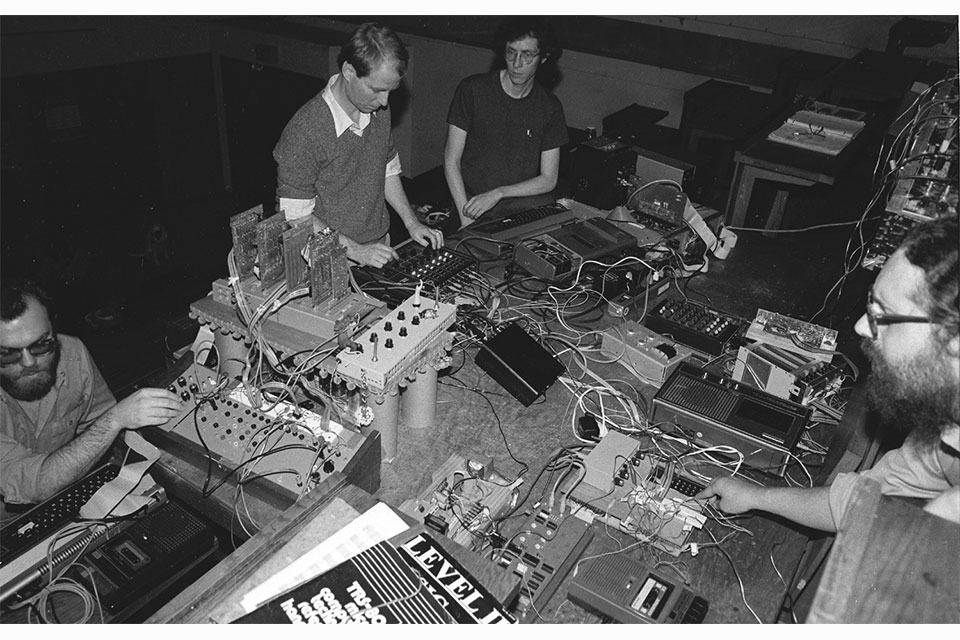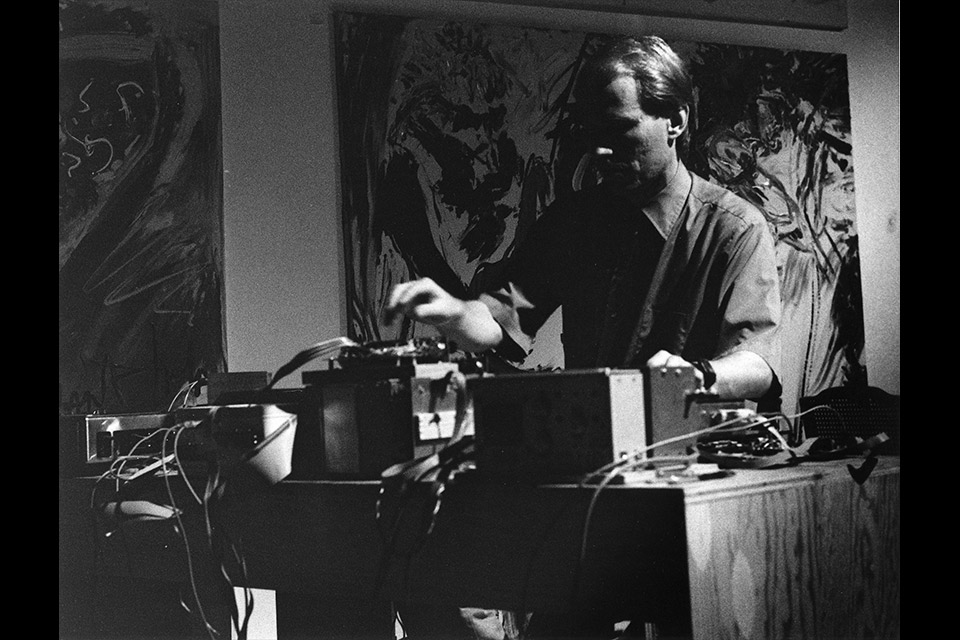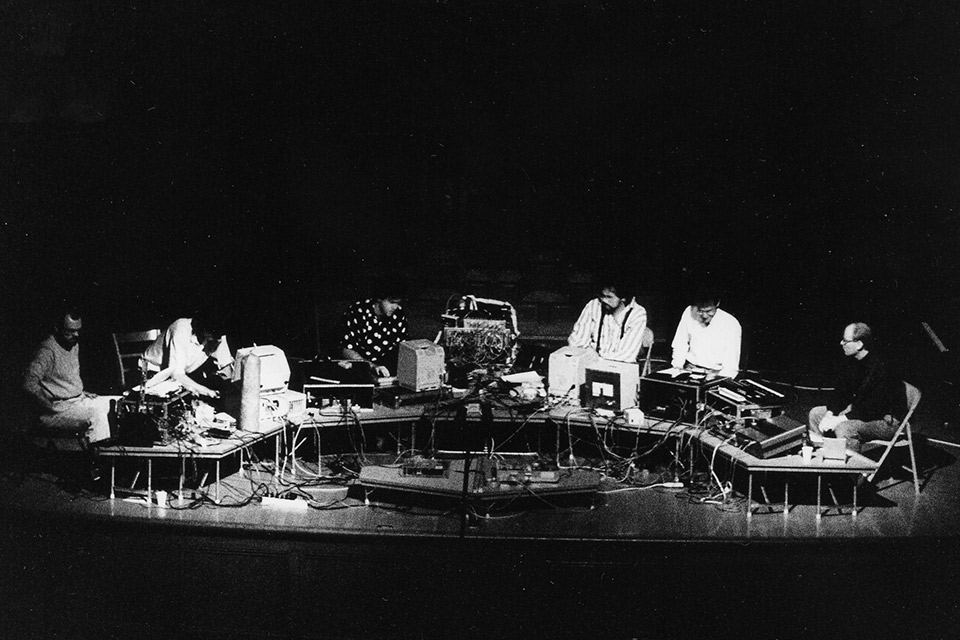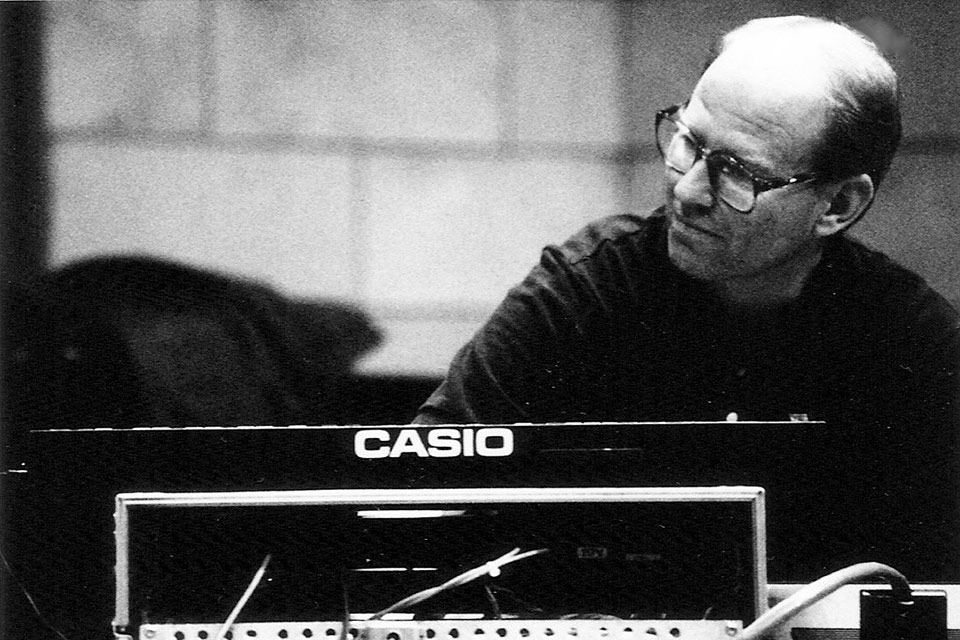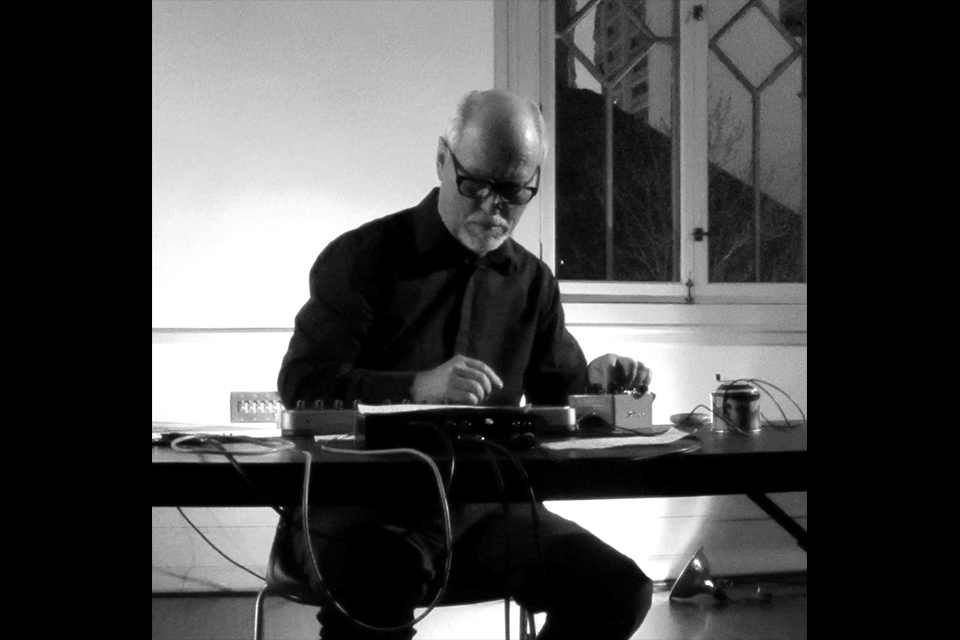Celebrating Electronics: Music by John Bischoff featuring James Fei and Tim Perkis
Mills Music Now
Saturday, April 24, 2021 | 7:00 PM PDT
Presented by Mills College Music Department and the Center for Contemporay Music
John Bischoff is a master composer/performer who explores boundaries and exchanges
between analog and digital sound in real-time. The subtle interchange between these
two realms is a form of musical alchemy, much in the tradition of the legendary composer/performer
David Tudor. Bischoff’s circuit/laptop configurations create musical forms both spontaneously
and algorithmically: a computer analyzes improvised analog sounds and creates musical
structures based upon pre-conceived algorithms. He aptly describes this process as
a “hybrid method that falls between traditional composition (invention ahead of time)
and free improvisation (invention in the moment).” The conceptual basis underlying
his music is rich; and the musical forms he creates are invariably elegant and coherent.
That Bischoff creates his compositions live in performance attest to his artistic
mastery. He is without doubt a leading composer/performer in the field of electronic
music.
- David Bernstein, Professor of Music, Music Department Chair
Tonight, Bischoff presents two solos that use the imperfect tones and sub-audio clicks of analog circuits to drive an array of digital synthesis elements. He will also be joined by electronics wizards, James Fei and Tim Perkis, in a new trio configuration. Inspired by the legendary League of Automatic Music Composers—Bischoff and Perkis were original members of the group—the trio spins parallel threads of electronic sound triggered by individual action, machine interjection, and event patterning culled from the instantaneous data flowing between their systems.
John Bischoff, electronics
James Fei, electronics
Tim Perkis, electronics
Program
Bitplicity (2020)
John Bischoff, electronics
Visibility Study (2015)
John Bischoff, electronics
League Trio (2021)
John Bischoff, James Fei, Tim Perkis - electronics
Notes
Bitplicity and Visibility Study start with pulse-wave oscillators sounding in audio and sub-audio realms that are animated by performer actions—primarily the momentary shorting of conductive points in each circuit. To accomplish this, the circuits are fabricated with critical trace points brought to the top of the circuit box in the form of brass rails. The rails run parallel to each other where they can be "shorted" with coins wielded by the performer. In some cases the coins are packaged into a variable resistance "sandwich" using anti-static foam as a filler. Compression of the foam varies the pitch of oscillation, an additional human-to-circuit control. (many thanks to Nicolas Collins for his inspiring book, “Handmade Electronic Music")
The solos share common structures throughout:
- as pulsed tones come to life, they sound at the loudspeakers and often trigger digital
sound at the same time
- the pulsed tones are also analyzed by the laptop for pitch content and elapsed time
between events
- the pitch and timing of subsequent digital synthesis generated by the laptop is
driven by this performance-acquired data—no pre-performance data is employed
- as the laptop generates sound it is open to interruption and re-initiation by ongoing
circuit actions
The very ground of each event in this music is a physical interruption—a disturbance in a continuous tone or silence. The usual electronic music preferencing of an acoustic-style envelope—the shaping of an attack followed by subsequent sustain and then release—is replaced by an ever-present potential for either sudden sound or sudden silence. The artifacts accompanying these transitions provide a site for sonic ornamentation—unpredictably complex edges of sound that balance the overly formal interior of electronic tone production.
League Trio grew out of a desire to reanimate some of the group music practices of The League of Automatic Music Composers—a band active 1978-83 that both Bischoff and Perkis played in, and which Fei was
interested in investigating. In the trio, symmetrical linkages between individual
electronic music systems were established from the start—both “to” and “from” audio
pathways wired between each pair of players, as well as data sharing via OSC (Open
Sound Control) consisting of broadcast messages from each player to the other two.
The messages reflect current musical action within 3 different timing realms: short,
medium, and long. As in the earlier League, the musical nature of each player’s instrument is left up to the player and their
individual approach to electronic performance. There is no overall “score” or pre-planned
sequence—decisions are made in the moment by the composers and reflected in the sound
we hear at the loudspeakers. The correlating influence of the information flowing
between systems serves to counterbalance this independence of action and contributes
to a classic synergy between whole and part.
- John Bischoff
Bios
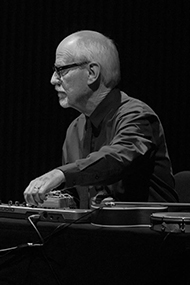 John Bischoff (b. 1949, San Francisco) is an early pioneer of live computer music. He is known
for his solo constructions in real-time synthesis as well as his development of computer
network music. Bischoff studied composition with Robert Moran, James Tenney, and Robert
Ashley. He has been active in the experimental music scene in the Bay Area for over
40 years as a composer, performer, and teacher. His performances around the US include
NEW MUSIC AMERICA festivals, Roulette and Experimental Intermedia in New York, and
the Lampo Series in Chicago. He has performed in Europe at the Festival d'Automne
in Paris, Akademie der Künste in Berlin, STEIM in Amsterdam, and Fylkingen in Stockholm.
He is a founding member of the League of Automatic Music Composers, the world's first computer network band, and co-authored an article on the League's
music that appeared in "Foundations of Computer Music" (MIT Press 1985). He is also
an original member of The Hub, a band he has performed and recorded with for over 3 decades. In 1999 he was awarded
an Artist Grant from the Foundation for Contemporary Arts in New York. He is also
a recipient of an Alpert Award/Ucross Residency Fellowship. Recordings of his work
are available on Artifact Recordings, Lovely Music, Tzadik, 23Five, Centaur, and New
World Records. As a member of the Hub, he was awarded a GigaHertz Prize for lifetime achievement in Electronic Music in 2018 by ZKM in Karlsruhe, Germany.
He recently retired from his faculty position at Mills, an institution with which
he has had a long and fruitful association.
John Bischoff (b. 1949, San Francisco) is an early pioneer of live computer music. He is known
for his solo constructions in real-time synthesis as well as his development of computer
network music. Bischoff studied composition with Robert Moran, James Tenney, and Robert
Ashley. He has been active in the experimental music scene in the Bay Area for over
40 years as a composer, performer, and teacher. His performances around the US include
NEW MUSIC AMERICA festivals, Roulette and Experimental Intermedia in New York, and
the Lampo Series in Chicago. He has performed in Europe at the Festival d'Automne
in Paris, Akademie der Künste in Berlin, STEIM in Amsterdam, and Fylkingen in Stockholm.
He is a founding member of the League of Automatic Music Composers, the world's first computer network band, and co-authored an article on the League's
music that appeared in "Foundations of Computer Music" (MIT Press 1985). He is also
an original member of The Hub, a band he has performed and recorded with for over 3 decades. In 1999 he was awarded
an Artist Grant from the Foundation for Contemporary Arts in New York. He is also
a recipient of an Alpert Award/Ucross Residency Fellowship. Recordings of his work
are available on Artifact Recordings, Lovely Music, Tzadik, 23Five, Centaur, and New
World Records. As a member of the Hub, he was awarded a GigaHertz Prize for lifetime achievement in Electronic Music in 2018 by ZKM in Karlsruhe, Germany.
He recently retired from his faculty position at Mills, an institution with which
he has had a long and fruitful association.
www.johnbischoff.com
 James Fei (b. Taipei, Taiwan) moved to the US in 1992 to study electrical engineering but lost
his way in music, becoming a composer, saxophonist and live electronic musician. Works
by Fei have been performed by the BBC Scottish Symphony Orchestra, Orchestra of the
S.E.M. Ensemble, Bang on a Can All-Stars, MATA Micro Orchestra and Noord-Hollands
Philharmonisch Orkest. Recordings can be found on Leo Records, Improvised Music from
Japan, CRI, Krabbesholm and Organized Sound. Compositions for Fei's own ensemble of
four alto saxophones focus on physical processes of saliva, fatigue, reeds crippled
by cuts and the threshold of audible sound production, while his sound installations
and performance on live electronics often focus on electronic and acoustic feedback.
Fei received the Grants for Artists Award from the Foundation for Contemporary Arts
in 2014 and he is president of Anthony Braxton's Tri-Centric Foundation. Fei has taught
at Mills College in Oakland since 2006, where he is Professor of Electronic Arts and
heads the Art and Technology Program.
James Fei (b. Taipei, Taiwan) moved to the US in 1992 to study electrical engineering but lost
his way in music, becoming a composer, saxophonist and live electronic musician. Works
by Fei have been performed by the BBC Scottish Symphony Orchestra, Orchestra of the
S.E.M. Ensemble, Bang on a Can All-Stars, MATA Micro Orchestra and Noord-Hollands
Philharmonisch Orkest. Recordings can be found on Leo Records, Improvised Music from
Japan, CRI, Krabbesholm and Organized Sound. Compositions for Fei's own ensemble of
four alto saxophones focus on physical processes of saliva, fatigue, reeds crippled
by cuts and the threshold of audible sound production, while his sound installations
and performance on live electronics often focus on electronic and acoustic feedback.
Fei received the Grants for Artists Award from the Foundation for Contemporary Arts
in 2014 and he is president of Anthony Braxton's Tri-Centric Foundation. Fei has taught
at Mills College in Oakland since 2006, where he is Professor of Electronic Arts and
heads the Art and Technology Program.
www.jamesfei.com
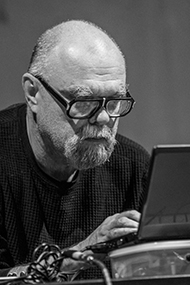 Tim Perkis (b. 1951) is a researcher, engineer, musician and filmmaker, who has been working
primarily in the field of digital sound for decades. As a musician, he is a founder
of The Hub, a pioneering group in the field of computer network music, as well as
a internationally-known performer of improvised music, having worked with many of
the leading figures in the field in North America, Europe and Japan. He has taught
at the California Institute of the Arts (CalArts) and the California College of the
Arts (CCA) and has been resident artist/researcher at Mills College in Oakland California,
Xerox Corporation's Palo Alto Research Center, Paul Allen's legendary thinktank, Interval
Research, and at the Mediterranean Institute of Advanced Research (IMéRA) of the
University of Aix-Marseille in France. As an engineer he has designed tools, toys
and software for a variety of corporate clients, including Mattel, Sony, and Sennheiser,
and consulted with the San Francisco Airport and Art Commission as an expert on technology-based
art. He is also producer and director of a feature-length documentary on musicians
and sound artists in the San Francisco Bay area called NOISY PEOPLE (2007),and a 2015
podcast series, also called NOISY PEOPLE. His music is available on over a dozen labels,
including Tzadik(USA), New World (USA), EMANEM(UK), Artifact(USA) and Leo(UK).
Tim Perkis (b. 1951) is a researcher, engineer, musician and filmmaker, who has been working
primarily in the field of digital sound for decades. As a musician, he is a founder
of The Hub, a pioneering group in the field of computer network music, as well as
a internationally-known performer of improvised music, having worked with many of
the leading figures in the field in North America, Europe and Japan. He has taught
at the California Institute of the Arts (CalArts) and the California College of the
Arts (CCA) and has been resident artist/researcher at Mills College in Oakland California,
Xerox Corporation's Palo Alto Research Center, Paul Allen's legendary thinktank, Interval
Research, and at the Mediterranean Institute of Advanced Research (IMéRA) of the
University of Aix-Marseille in France. As an engineer he has designed tools, toys
and software for a variety of corporate clients, including Mattel, Sony, and Sennheiser,
and consulted with the San Francisco Airport and Art Commission as an expert on technology-based
art. He is also producer and director of a feature-length documentary on musicians
and sound artists in the San Francisco Bay area called NOISY PEOPLE (2007),and a 2015
podcast series, also called NOISY PEOPLE. His music is available on over a dozen labels,
including Tzadik(USA), New World (USA), EMANEM(UK), Artifact(USA) and Leo(UK).
www.perkis.com
More information about Mills Music Now.
